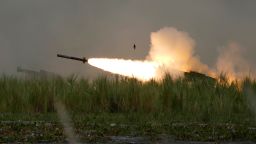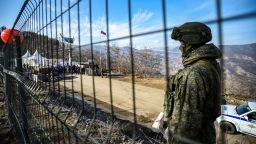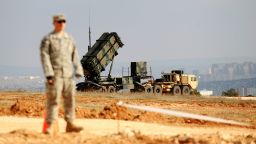Editor’s Note: David A. Andelman, a contributor to CNN, twice winner of the Deadline Club Award, is a chevalier of the French Legion of Honor, author of “A Red Line in the Sand: Diplomacy, Strategy, and the History of Wars That Might Still Happen” and blogs at Andelman Unleashed. He formerly was a correspondent for The New York Times and CBS News in Europe and Asia. The views expressed in this commentary are his own. View more opinion at CNN.
The war in Ukraine entered 2023 with its deadliest attack yet on Russian troops – and an attempt by Moscow to shift the bulk of blame onto its own dead soldiers.

Shortly after midnight on New Year’s Day, a Ukrainian strike on the occupied city of Makiivka killed dozens of troops, with Russia’s Ministry of Defense claiming its soldiers’ cell phone use exposed their location.
Regardless of whether Russia lost 400 men as Ukraine claims, or 89 as Moscow says, the result of the attack is the same: Russia’s highest single-incident death toll since the war began more than 10 months ago.
If the Russian account is accurate, it was the cell phones that the novice troops were using in violation of regulations that allowed Ukrainian forces to target them most accurately. Ukraine, however, has not indicated how the attack was executed. But the implications are broader and deeper, especially for how Russia is conducting its war now.
The Makiivka strike underlines not just Ukraine’s western-backed weapons capabilities, but Russia’s ongoing colossal strategic errors, made from either ignorance, incompetence or simple negligence.
It is telling that days after the deadliest known attack on Russian servicemen, President Vladimir Putin called for a temporary ceasefire, citing the Orthodox Christmas holiday. The move was rightly dismissed by Ukraine and the US as a cynical attempt to seek breathing space amid a very bad start to the year for Russian forces.
As US President Joe Biden said of Putin, “I think he’s trying to find some oxygen.”
Lines of communication
Russian officials said that four Ukrainian-launched HIMARS rockets hit the vocational school where its forces were housed, apparently adjacent to a large arms depot. (Another two HIMARS rockets were shot down by Russian air defenses).
This account would seem to validate continued, even expanded, use of the HIMARS weapons systems the United States has been supplying to Ukraine.
The satellite-guided HIMARS — short for High Mobility Artillery Rocket System — currently have a range of 80 kilometers. A longer-range 300-kilometer HIMARS has not yet been authorized, despite repeated Ukrainian pleas. (The Biden administration has worried that the longer-range system could expand the war beyond Ukraine’s frontiers and lead to an escalation of hostilities.)
Russia meanwhile continues to stockpile arms and ammunition in large quantities close to the troops they will supply and well within range of enemy weaponry. Standard military practice dictates that large depots be broken up and scattered and that they be located far behind enemy lines — even within Russian territory that western powers have declared off-limits to Ukrainian strikes.
Chris Dougherty, a senior fellow for the Defense Program and co-head of the Gaming Lab at the Center for New American Security in Washington, has told me that Russia’s failure to break up or move large arms depots is largely a function of the reality that their forces cannot communicate adequately.
As a result of this poor communications, commanders would not know what reserves were available to them if supplies were widely scattered.
It’s a view shared by other experts. “Bad communications security seems to be standard practice in the Russian Army,” James Lewis, director of the Strategic Technologies Program at the Center for Strategic and International Studies (CSIS), told me in an e-mail exchange.
Unprofessional and ill-equipped
Compounding the problem, Britain’s Ministry of Defense said after the recent Makiivka strikes that “the Russian military has a record of unsafe ammunition storage from well before the current war, but this incident highlights how unprofessional practices contribute to Russia’s high casualty rate.”
The troops killed in Makiivka seem to have been recent conscripts, part of a larger picture of Russian soldiers being shipped to the front lines with little training and deeply sub-standard equipment and weapons.
Indeed, a number of the most recent arrivals to the war are inmates from Russian prisons, freed and transferred immediately to the Ukrainian front. One can only imagine how appealing the use of cell phones would be to prisoners accustomed to years of isolation with little or no contact with the outside world.
What the war bloggers are saying
The errors by the Russian military are now becoming so blatant, and as the Makiivka attack shows, so deadly to Russian forces, that some of Putin’s most ardent apologists have now begun turning on the military establishment.
Semyon Pegov, who blogs under the alias WarGonzo and was personally awarded the Order of Courage by President Vladimir Putin at the Kremlin two weeks ago, attacked the Ministry of Defense for its “blatant attempt to smear blame” in suggesting it was the troops’ own use of cell phones that led to the precision of the attack.
He questioned how the Ministry of Defense could be “so sure” that the location of soldiers lodging in a school building could not have been determined using drone surveillance or a local informant.
He’s not the only Russian war blogger casting doubt. “As expected, the blame for what happened in Makiivka began to be placed on the soldiers themselves,” said a post on the Telegram channel known as “Grey Zone,” linked to longtime Kremlin ally Yevgeny Prigozhin, leader of the Wagner Group of mercenaries. “In this case, it is to 99% a lie and an attempt to throw off the blame.”
Where Putin fits in the picture
The question is when the blame will begin shifting from the military to Putin himself, particularly since he has seemed ill-prepared to change the leadership at very the top. The last change was the appointment of Sergei Surovikin as the first person to be placed in overall command of all Russian forces on the Ukraine front — an army general formerly in charge of the brutal Russian bombardment of Aleppo in Syria.
A month earlier, the defense ministry underwent a shakeup when Col. Gen. Mikhail Y. Mizintsev, known to Western officials as the “butcher of Mariupol,” was named deputy defense minister for overseeing logistics, replacing four-star Gen. Dmitri V. Bulgakov, who had held the post since 2008. The location of the arms depot, adjacent to the Makiivka recruits, would likely have been on Mizintsev’s watch.
Still, Putin-favorite Sergei Shoigu remains defense minister — as recently as Saturday, before the Makiivka attack, telling his forces in a celebratory video: “Our victory, like the New Year, is inevitable.”
How long Putin can insulate himself and prevent the blame from turning on himself is the key question in the wake of Makiivka. There is no indication that Ukrainian forces have any intention of lessening the pressure on Russian forces in the east or south of their country as the war enters a new calendar year.
And there seems to be little suggestion that the West will be letting up on its support for Ukraine. Both the US and increasingly Europe, which recently committed to raising its funding by $2 billion in 2023, appear determined to see Ukraine through this winter and beyond.
Just this week, the Biden administration announced the US was considering dispatching Bradley armored fighting vehicles to Ukraine. French President Emmanuel Macron also announced he would be sending light tanks, though Ukrainian president Volodymyr Zelensky was urging the dispatch of heavier battle tanks. All of which puts German Chancellor Olaf Scholz under increasing pressure to add its powerful Leopard 2 tanks to the mix.
It’s an impressive weapons wish list. And overall, a very good start to the new year for the forces of democracy.



